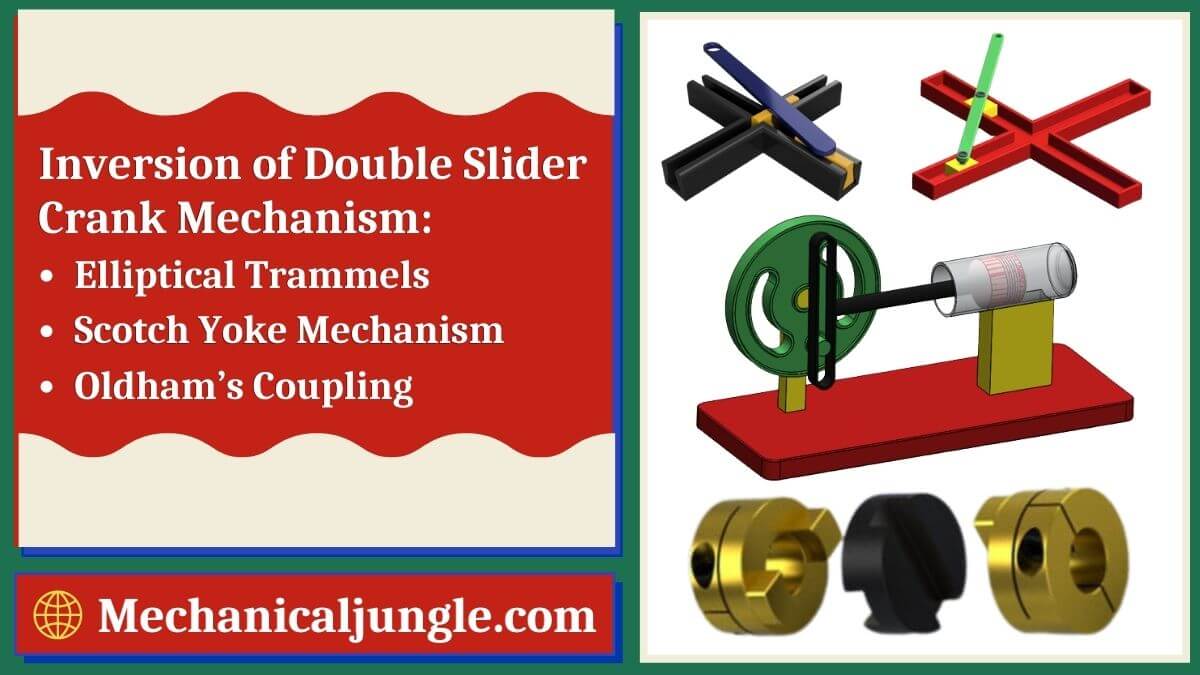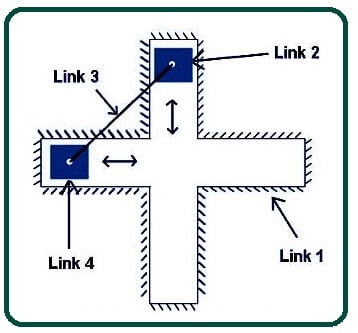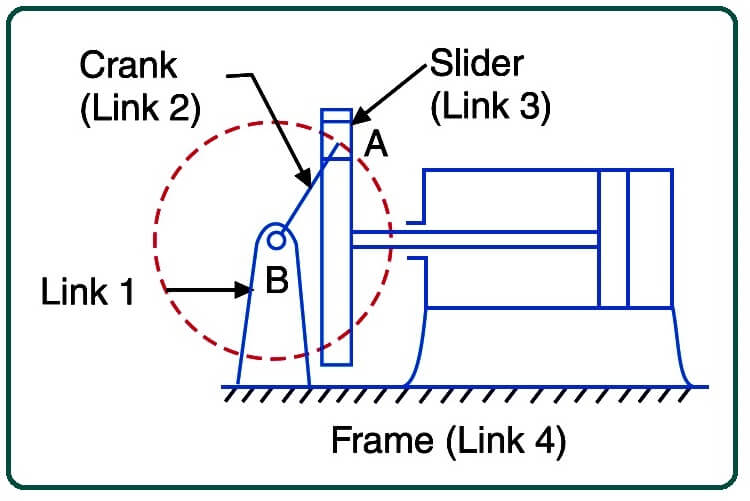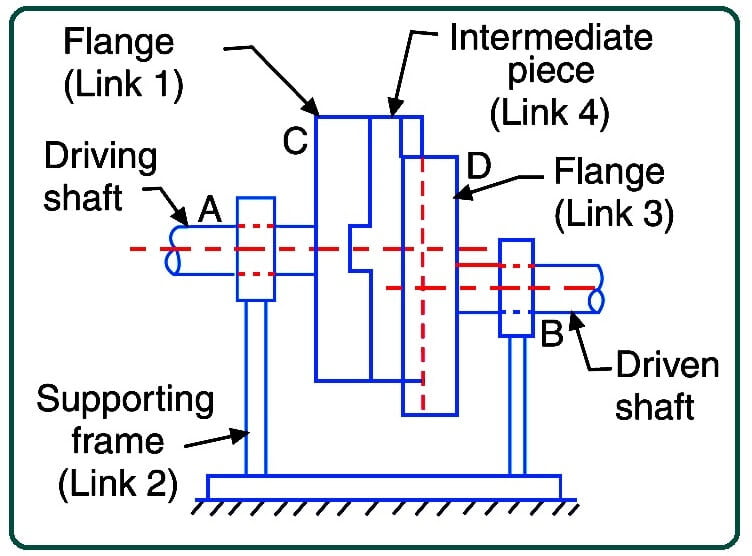Important Point
Inversion of Double Slider Crank Mechanism:
- The double slider crankshaft has two sliding pairs and two twist pairs. It is named double slider crankshaft because it has two sliding pairs. It has two sliders, a frame in which the slider moves, and a link that connects the two slides and fixes the distance between the two sliders.
- The frame in which sliders move is a combination of two straights grooves that form a single link and cut eaches other at right angles.
In a different inverse of double slider crank chain: –
- The frame is Link 1.
- The first slider is link 2.
- The bar connecting two sliders is Link 3.
- The second Slider is Link 4.
There are three important inversions of the double slider crank chain. These three are:-
- Elliptical Trammels.
- Scotch Yoke Mechanism.
- Oldham’s Coupling.
Also, Read: Working of Kaplan Turbine | What Is a Kaplan Turbine? | Main Parts of Kaplan Turbine
1. Elliptical Trammels:-
- This type of inverse is used to draw the ellipse. It is also known as the trend of Archimedes. It can be used to draw ellipses of different sizes.
- In this inverse link 1, i.e., the frame is fixed. Both sliders, link 2 and link 4, run in the grooves of this frame. One slider moves vertically, and the other slider moves horizontally.
- The connecting rod link 3, which connects the two sliding bars, link 2 and link 4, constrain the motion of these sliding bars. While the two sliders move, each point in the connecting rod is the location of an ellipse.
- The different points in the connecting rod will draw a different ellipse.
Also, Read: Vane Blower Compressor | Construction of Vane Compressor | Working of Vane Compressor
2. Scotch Yoke Mechanism:-
- Scotch Yoke mechanisms are used for converting rotary motion into a reciprocating motion. The inversion is obtained by fixing either link 1 or link 3. In, link 1 is fixed. In this mechanism, when link 2 (which corresponds to crank) rotates about B as center, link 4 (which corresponds to a frame) reciprocates. The fixed link 1 guides the frame.
- Now, the second slider will rotate around the fixed slider and will draw a circle if its path is traced. If the frame or slanted plate will move forward and if the horizontal moving slider is fixed and the frame will move up and down, then the vertical moving slider is fixed.
Also, Read: Autocollimator Working | Principle of Autocollimator | Parts of Autocollimator | Types of Autocollimator
3. Oldham’s Coupling:-
- Oldham couplings are used to connect two shafts whose axles are separated from each other and rotate them at equal speed.
- An Oldham coupling mechanism is used to connect two parallel shafts whose axes are separated at short distances. The shaft is coupled in such a way that if one shaft rotates, the other shaft also rotates at the same speed. This inverse is achieved by fixing link 2. The shaft to be connected have two flanges (link 1 and link 3), fastened strictly to their ends by forging.
- It forms the coupling of the inverted Oldham. Now we will discuss how it is used to connect two shafts whose axis is slightly different from each other.
- This shaft is connected in such a way that if one shaft rotates, the other shaft also rotates at the same speed.
- The two flanges are placed at the end of the two shafts that are to be connected. These flanges are rigidly fastened at the end by forging. Both flanges have grooves.
- The groove of both flanges is perpendicular to each other. Between these two flanges, a central flange is inserted, which fits into the grooves of both flanges.
- In this coupling, which is fixed frame links 3, driving shaft and driving flange for link 2, intermediate flange link 1, and driveshaft and flange form link 4.
- When the first shaft, i.e., The driving shaft, rotates, the forged one also rotates, and then the central flange placed in the grooves of the driving flange starts rotating.
- Then the driven flange also starts rotating because the center flange is also fixed in the grooves of the driven flange, and as the driven flange rotates, the driven shaft also starts rotating at the same speed.
Frequently Asked Questions (FAQ)
Inversion of Double Slider Crank Mechanism
An elliptical trammel (also known as the Trammel of Archimedes) is used to draw ellipses of various sizes. Elliptical Trammel is an inversion of a double slider crank chain in which there are two sliding pairs and two turning pairs. Slider 1 (Link 4) moves vertically while slider 2 (Link 2) moves horizontally.
Double Slider Crank Mechanism
The double slider crankshaft has two sliding pairs and two twist pairs. It is named the double slider crankshaft because it has two sliding pairs. It has two sliders, a frame in which the slider moves, and a link that connects the two slides and fixes the distance between the two sliders.
Scotch Yoke Mechanism
The Scotch yoke mechanism is a reciprocating motion mechanism, converting the linear motion of a slider into the rotational motion of a crank or vice versa. In the present study, it has been considered that the gravitational forces are perpendicular to the motion plane.
Elliptical Trammels
The Elliptical Trammel (also known as the Elliptic Trammel or the Trammel of Archimedes) is a simple mechanism that can trace an exact elliptical path. Shows the geometry of this mechanism, which consists of two prismatic (or sliding) joints and two revolute (or rotational) joints.
Oldham’s Coupling
The Oldham coupling is a form of flexible coupling designed for applications that must be free from backlash. They are also increasingly being used as a replacement for straight jaw couplings.
Like this post? Share it with your friends!
Suggested Read –
- What Is Pipe Joint? | Types of Pipe Joints
- Application of Cotter Joint | What Is a Cotter Joint | Types of Cotter Joint | Application of Cotter Joint
- Jigs and Fixtures | What Is a jig | Types of Jigs | Jigs of Jigs and Fixtures | What Is a Fixture | Types of Fixtures | Fixtures of Jigs and Fixtures
- Turbine Function | Turbine Function of Thermal Power Plant | What Is Steam Turbine Function | Working Principle of Steam Turbine Function
- Pattern Allowances In Casting | Why the Pattern Allowances In Casting Affected | Finishing or Machining Allowance | Shake or Rapping Allowance





Leave a Reply